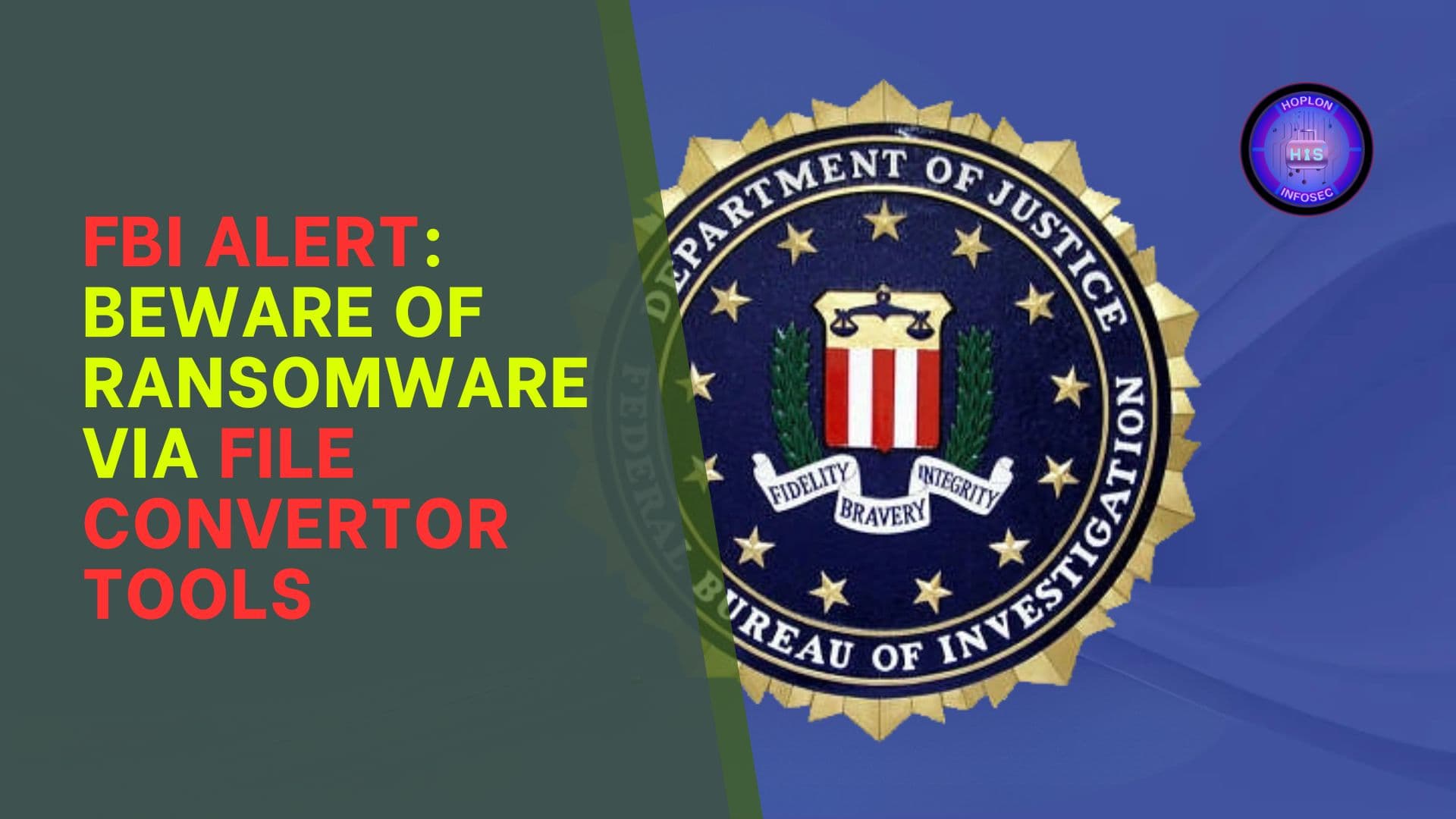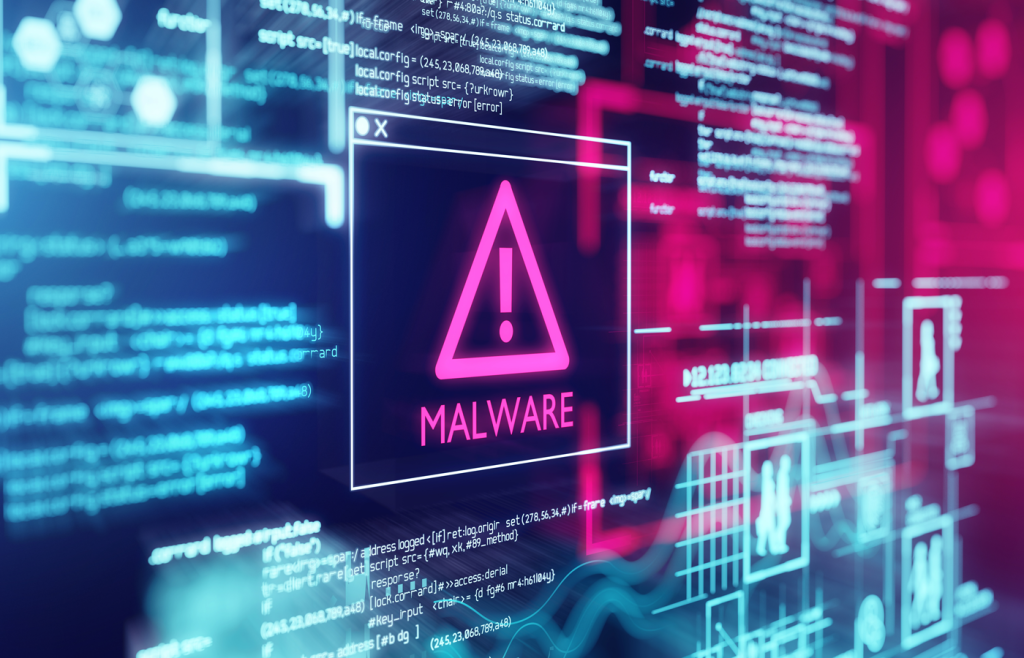FBI Alert: Beware of Ransomware via File Convertor Tools

Hoplon InfoSec
25 Mar, 2025
Recently, the Federal Bureau of Investigation’s Denver Field Office issued an urgent FBI Alert about a sophisticated cybersecurity threat increasingly targeting individuals and organizations across the United States. This blog post explores the intricacies of the danger, explains how cybercriminals deploy malicious software through seemingly innocent online file conversion tools, and provides comprehensive advice on protecting your valuable digital assets. By understanding this evolving threat and adopting robust security practices, you can significantly reduce the risk of a cyberattack.
The Emergence of a Sophisticated Cyber Threat and FBI Alert

The FBI’s Denver Field Office alert underscores a disturbing trend: cybercriminals exploit free online file conversion services to distribute malware. These malicious actors disguise their software as legitimate conversion tools capable of converting files—from documents to images and media files—into different formats. The core of this threat lies in the dual nature of these services. While successfully performing the advertised conversion functions, they simultaneously install hidden malware that grants unauthorized access to victims’ systems.
The Strategy Behind Malicious Conversion Services
Cybercriminals employ a straightforward yet effective strategy. They develop websites that mimic reputable online file conversion services, offering a variety of conversion capabilities, such as converting .doc files to .pdf format, merging multiple .jpg images into a single document, or downloading MP3 and MP4 media files. These services are often free and appear user-friendly, which lowers the guard of unsuspecting users. Once a user initiates a conversion, the malware is covertly installed onto the device. This malware is designed to remain hidden while it creates a backdoor for cybercriminals to access and control the system.
Insights from Law Enforcement
FBI Denver Special Agent in Charge Mark Michalek has stressed the importance of education in combating these threats. “The best way to thwart these fraudsters is to educate people so they don’t fall victim to them in the first place,” he stated. This comment highlights the widespread nature of the threat and the urgent need for public awareness. The rapid spread of these malicious services indicates that cybercriminals are refining their methods to target more victims, making vigilance and knowledge essential components of digital security.
How Malicious File Converters Operate
Understanding the operational mechanics of these deceptive services is critical to defending against them. Cybercriminals behind these tools are not merely offering file conversion; they are leveraging the process to infiltrate systems and extract sensitive information.
Dual Functionality: Legitimate Conversions with Hidden Dangers
On the surface, these online tools provide valuable services. They perform the conversion tasks as promised, whether converting a Word document into a PDF or combining multiple image files into one. However, hidden malware is being installed in the background alongside these legitimate functions. This malware is programmed to remain undetected while it gathers data or provides cybercriminals with unauthorized access to the victim’s device. The hidden installation process is often seamless, making it difficult for users to notice that something has gone wrong.
Recent Activity in Local Areas
Assistant Special Agent Marvin Massey has confirmed that incidents related to these threats have been reported as recently as two weeks ago within the Denver metro area. This confirmation from law enforcement is a stark reminder that this threat is active and evolving. It highlights the need for continuous vigilance and regular security practice updates for individuals and organizations.
Real-World Examples of Malicious Domains

Security researchers have meticulously identified several domains involved in these operations. By analyzing these examples, users can better understand how cybercriminals camouflage their activities and how to detect potential red flags.
Notable Malicious Domains and Their Functions
Among the domains identified are “imageconvertors[.]com,” which has been associated with phishing attacks; “convertitoremp3[.]it,” which is linked to riskware; and “convertscloud[.]com,” which is also known for phishing schemes. These domains are examples of how cybercriminals use slightly altered or misspelled versions of reputable names to trick users into trusting them. The manipulation of domain names is a common tactic designed to exploit users’ familiarity with legitimate online services.
A Case Study: The Impersonation of a Legitimate Service
Cyble Research and Intelligence Labs uncovered a particularly concerning case involving a phishing site called “convertigoto.net.” This website was designed to impersonate the legitimate Convertio service. When users believed they were downloading their converted files, they instead received a zip archive containing a malicious shortcut file named “YourConvertedFile.lnk.” Once executed, this file unleashed the RedLine Stealer malware—a tool that can extract sensitive data from various applications and web browsers. This case demonstrates the lengths cybercriminals will go to appear legitimate, exploiting the trust users place in well-known services.
The Far-Reaching Impact of Malware Attacks

The malware delivered by these deceptive file conversion services, such as RedLine Stealer, is hazardous due to its extensive data theft capabilities. Once installed on a system, the malware can extract sensitive information, exposing users to significant risks.
Personal Data at Risk
One of the malware’s primary objectives is to harvest personal identifying information. This includes Social Security numbers and other critical data that can be used to perpetrate identity theft. The loss of such information can lead to long-term financial and personal repercussions, making users guard their data carefully.
Financial Information and Cryptocurrency Vulnerabilities
Beyond personal identification, the malware is designed to collect banking credentials and other financial data. Cybercriminals can use this information to gain unauthorized access to bank accounts, execute fraudulent transactions, or steal funds. Moreover, the malware targets cryptocurrency wallets by extracting wallet addresses and seed phrases. This dual focus on traditional banking and emerging digital currencies amplifies the potential financial damage from a successful attack.
Breaching Digital Fortresses: Browser and Application Data
The threat extends to the digital tools that many people use daily. By infiltrating web browsers, malware can harvest cookies, autofill data, and save passwords—data often enough for a hacker to hijack online sessions and access secure accounts. Applications such as FileZilla, Discord, Steam, and Telegram are also vulnerable, as the malware can extract information stored within these platforms. This comprehensive approach to data theft underscores the multi-faceted nature of modern cyberattacks.
Recognizing the Warning Signs of Malicious Converters
Despite the sophistication of these cyberattacks, several key indicators can help users identify potentially dangerous online conversion tools. Awareness of these red flags is vital in protecting your digital life.
Suspicious Domain Names and Misspellings
One of the first signs of a potential threat is an unusual or misspelled domain name. Cybercriminals often register domains that are deceptively similar to those of reputable companies. If you notice slight spelling or domain structure discrepancies, it could be a deliberate attempt to mimic a trusted service.
Unexpected Download Prompts
Another warning sign is the unexpected download of files. Genuine online conversion services typically do not prompt users to download additional files, significantly compressed archives, or shortcut files. If you are encouraged to download something immediately after conversion, pausing and verifying the website’s legitimacy is wise.
Lack of Secure Connection Indicators
Security is a fundamental aspect of any reputable website. Always look for HTTPS in the website’s URL, as it indicates that the connection between your browser and the site is encrypted. A lack of HTTPS or the presence of a security warning in your browser can signal that the site is not secure, and you should exercise caution.
Unsolicited Offers or Vague Branding
Often, malicious sites do not have clear branding or affiliations with well-known companies. If an online conversion tool appears generic, lacks professional design cues, or makes unsolicited offers without proper context, it may be best to avoid using it. Legitimate services typically have clear, consistent branding backed by verifiable credentials.
Best Practices for Protecting Your Digital Assets

Given the severity and sophistication of these threats, it is essential to adopt a comprehensive approach to digital security. Implementing various best practices can help safeguard your systems and sensitive data from cybercriminals.
Download Software Only from Trusted Sources
A foundational digital security principle is downloading software and accessing services only from trusted sources. This means relying on official websites and recognized app stores rather than third-party sites that might host compromised or counterfeit software. Verified sources are less likely to be associated with malicious activities, reducing your risk of encountering harmful malware.
Maintain Up-to-Date Security Software
Keeping your antivirus and anti-malware programs updated is critical. Cybercriminals constantly evolve their techniques, and updated security software is better equipped to detect and neutralize emerging threats. Regular system scans help identify potential vulnerabilities early, allowing for prompt remediation before significant damage occurs.
Utilize Built-In Conversion Tools When Available
Use the built-in file conversion tools that come with your operating system or trusted productivity software whenever possible. Many modern applications offer native conversion functionalities that eliminate the need for third-party services. This simplifies the conversion process and minimizes exposure to potentially dangerous online tools.
Educate Yourself and Your Team
Awareness and education are robust defenses against cybercrime. Whether you are an individual user or part of an organization, staying informed about the latest threats and understanding how they operate is crucial. Regular cybersecurity training sessions, participation in webinars, and subscribing to trusted cybersecurity news sources can help you and your team remain vigilant and well-prepared.
Implement Multi-Factor Authentication
Multi-factor authentication (MFA) is an effective security measure that protects your accounts. By requiring multiple verification forms before granting access, MFA significantly reduces the risk of unauthorized entry, even if login credentials are compromised. Incorporating MFA into your security practices can be a decisive factor in preventing data breaches.
Regular Backups: Your Safety Net
Maintaining regular backups of your important files is one of the most reliable ways to mitigate the effects of a ransomware attack or malware infection. Storing backups on a secure, separate device or cloud service ensures that your critical data remains safe, even if your primary system is compromised. Regularly scheduled backups provide a safety net that can minimize downtime and financial losses.
Reporting Suspicious Activity
If you suspect you have encountered or fallen victim to a malicious file conversion tool, it is crucial to report the incident immediately. The FBI’s Internet Crime Complaint Center (IC3) is a valuable resource for reporting cybercrimes. By reporting suspicious activities, you contribute to broader efforts to track and dismantle these malicious networks, ultimately protecting other users from similar attacks.
Proactive Steps to Take If You’re Infected
Despite your best efforts, if you suspect that your system has been compromised, prompt action is essential. Immediate steps can mitigate the damage and help secure your information before it falls into the wrong hands.
Disconnect from the Internet
One of the first steps is disconnecting your device from the Internet. This prevents the malware from communicating with its command and control servers and stops further data exfiltration. Disconnecting quickly can limit the damage and reduce the likelihood of additional sensitive information being compromised.
Notify Financial Institutions
If there is any indication that your banking credentials or financial information has been compromised, contact your bank or credit card company immediately. Informing your financial institution allows them to monitor your accounts for suspicious activity and take steps to secure your financial assets.
Change Passwords Securely
Using an uninfected device, change the passwords for all your accounts, particularly those that store sensitive or financial information. Strong, unique passwords are essential for each account, and a reputable password manager should be employed to keep track of them securely.
Seek Professional Malware Removal Services
Sometimes, malware infections can be deeply embedded within a system, making manual removal difficult. In such cases, consider hiring professional malware removal services. Cybersecurity experts can thoroughly scan your system, remove any malicious software, and help you restore your device to a secure state.
The Broader Implications of Cybercrime
Cyber threats like those posed by malicious file conversion tools have far-reaching implications for individuals and organizations. The impacts extend beyond immediate financial losses, affecting personal privacy, organizational reputation, and overall digital trust.
Personal Consequences of Data Breaches
For individuals, unauthorized access to personal data can result in identity theft, fraudulent financial transactions, and long-term credit and personal security issues. The emotional and economic toll of dealing with identity theft and the aftermath of a data breach can be significant, often requiring extensive time and resources to resolve.
Organizational Risks and Reputational Damage
A successful cyberattack can lead to severe disruptions for businesses and organizations. Beyond the immediate costs associated with mitigating the breach and restoring systems, organizations may suffer lasting reputational damage. Loss of customer trust, legal liabilities, and regulatory fines are common consequences that can impact an organization’s bottom line and long-term viability. The interconnected nature of modern digital infrastructure means that an attack on one business component can cascade effects throughout the operation.
Global Scale and the Need for International Cooperation
Cybercrime is a global challenge, transcending national borders. The methods employed by cybercriminals can be replicated and adapted to target users worldwide. This global scale underscores the need for international cooperation in cybersecurity. By sharing threat intelligence and collaborating on security protocols, countries and organizations can build a more resilient digital infrastructure better equipped to withstand the evolving tactics of cybercriminals.
Conclusion: Strengthening Your Digital Defenses

The threat posed by malicious file conversion tools is a stark reminder of the vulnerabilities inherent in our increasingly digital world. Cybercriminals continuously refine their methods, blending legitimate services with hidden dangers to exploit unsuspecting users. However, by understanding the mechanics of these attacks and adopting a proactive approach to cybersecurity, you can significantly reduce your risk of falling victim to such schemes.
In conclusion, maintaining vigilance is paramount. Always download software from trusted sources, update your security tools, and utilize built-in functionalities provided by reputable software to minimize exposure to malicious services. Educating yourself and your team about cyber threats is a powerful strategy for preventing future attacks.
By taking proactive measures—such as implementing multi-factor authentication, maintaining regular backups, and reporting suspicious activity—you can fortify your defenses against even the most sophisticated cyber threats. While no system is foolproof, a layered security approach can help mitigate risks and protect personal and organizational data.
Cybersecurity is an ongoing battle, and cybercriminals’ tactics will continue to evolve. As technology advances, so too must our methods of defense. Staying informed, remaining cautious, and continually investing in the latest security measures are essential in today’s digital environment. In this fight against cybercrime, knowledge, and vigilance are your most powerful tools.
Remember, every precaution you take contributes to a broader cybersecurity culture that protects you and supports a safer digital community for everyone. Stay informed, stay proactive, and take charge of your digital security.
For more: Cybersecurity News
Share this :